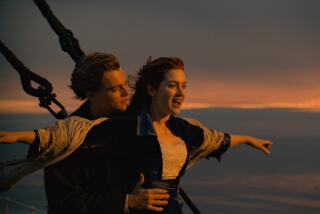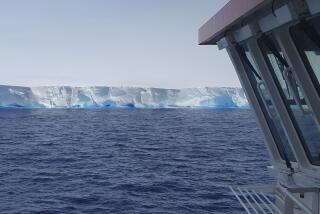Scientists Get Closest Look Yet at Titanic
- Share via
WOODS HOLE, Mass. — Scientists in a special submarine saw the grand staircase leading to the ballroom and first-class salon of the Titanic on Monday in the closest look at the luxury liner since it struck an iceberg and sank 74 years ago.
“It was spectacular,” said Robert Ballard, leader of the Navy-financed expedition. “We took superb color video pictures.”
Ballard talked by telephone from the research vessel Atlantis 2 about 400 miles south of Newfoundland in a call to the Woods Hole Oceanographic Institution.
Speaking after spending more than four hours on the ocean bottom, Ballard said he and two crew members aboard the submarine went back and forth along the outside of the liner, which sank April 15, 1912, carrying 1,500 people to their deaths.
Plans to Use Robot
Ballard told Navy Cmdr. Mark Neuhart that he plans to put a self-propelled robot laden with cameras inside the staircase today for the first pictures of the ship’s interior. A hole was left by the implosion of a huge glass dome above the staircase.
Ballard and his companions, who were the first humans since the sinking to gaze upon the wreck, said they could see both anchors, rows of portholes with the glass intact and the upper deck, which he said was dipping forward.
“We couldn’t see the name,” Ballard said. “There are rivers of rust pouring down the side of the ship down onto the sediment.”
It took more than two hours for the submarine to reach the wreck, nearly 13,000 feet below the surface, and more than two hours to ascend.
“We landed where the wheelhouse was and saw the ship’s wheel minus the wood,” Ballard said. “We then left and drove over the No. 1 funnel opening and out over the grand staircase.”
Cameras Mounted on Hull
The photographs were taken by cameras mounted on the hull of the submarine. Researchers aboard the Atlantis 2 began processing the 3,000 photographs.
Ballard also ran the camera robot through final tests before the 11-day photographic probe of the interior of the ship begins.
It was the first time the self-propelled robot, which resembles a lawn mower, had been operated at such depths. “The little fellow was A-OK,” said Rick Chandler of the Deep Submergence Laboratory at the Woods Hole Oceanographic Institution.
More to Read
Sign up for Essential California
The most important California stories and recommendations in your inbox every morning.
You may occasionally receive promotional content from the Los Angeles Times.













